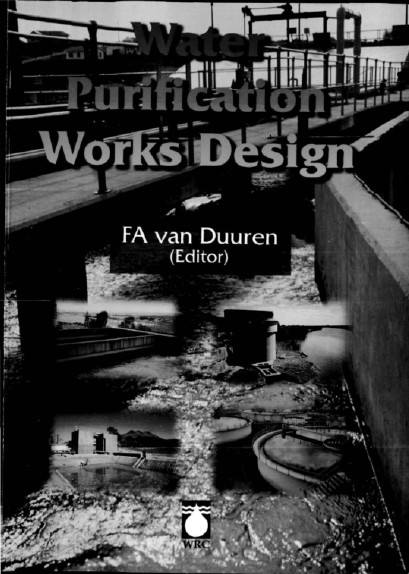Water purification works design
 |
WRC Report No: TT 92/97
rapport Aug 1997 ; 434 pages
Aut. F.A. van Duuren
Ed. WRC - Pretoria ; Isbn: 1 86845 345 6
Téléchargeable sous format: PdF
Téléchargeable chez l'éditeur
Page de présentation d'un éditeur
Abstract:
The objective of water purification is to produce a sufficient amount of the most suitable product economically. This is done on the basis of water quality and quantity considerations, processes and operations. The health and hygienic aspect of water is of primary importance for domestic purposes. However, purified water should also be aesthetically pleasing, non-corrosive or scale-forming and it should meet a number of other quality requirements.
The purpose of water treatment is to modify or alter one or more of the quality parameters of the water for a particular purpose. A knowledge of the quantum of water required for domestic and industrial purposes is essential to the sizing of water works. Water needs and requirements for domestic and industrial purposes therefore have to be assessed as a first step to design. A water source has to be obtained to suit these needs.
The quality aspects of water include those of the raw water resources and of the purified and treated water. These qualities have implications on and in fact would determine the purification and treatment processes. The processes include coagulation, disinfection and treatment for example, to control corrosion and scale formation. It is necessary to know what water works chemicals, coagulants and disinfectants are desirable and are available. The purposes to be achieved by the use of these have to be known. The unit operations considered, include dispersion and mixing of coagulants after addition to the raw water, flocculation, sedimentation, clarification, flotation, filtration, sludge and wash water disposal. The availability of various types of plant and equipment involved in the processes and operations, especially locally has to be known. Other aspects which are of importance in water purification and treatment include raw water intakes and disinfection contact tanks. The mechanical and electrical plant and equipment for the various unit operations are of interest and are dealt with. Instrumentation, including flow, turbidity and other measurements is also given consideration. Planning, costing and estimation, operation, control and management of water works is given some consideration as they affect design and is affected by it.
This text has been structured for and is aimed at water works design engineers and planners. It should also be of some value to water engineering lecturers and their post graduate students. It is certainly didactic, having been largely written by engineers - the reader is nevertheless urged to use it in the good spirit in which it is offered.
Publics-Cibles:
Mots clefs: |
potabilisation (CI) (DT) (OP) (ope) , technologie (CI) (DT) (OP) (ope) |
Editeur/Diffuseur: |
|
WRC
-
Water Research Commission - Pretoria - Afrique du Sud |
En cas de lien brisé, nous le mentionner à communication@pseau.org